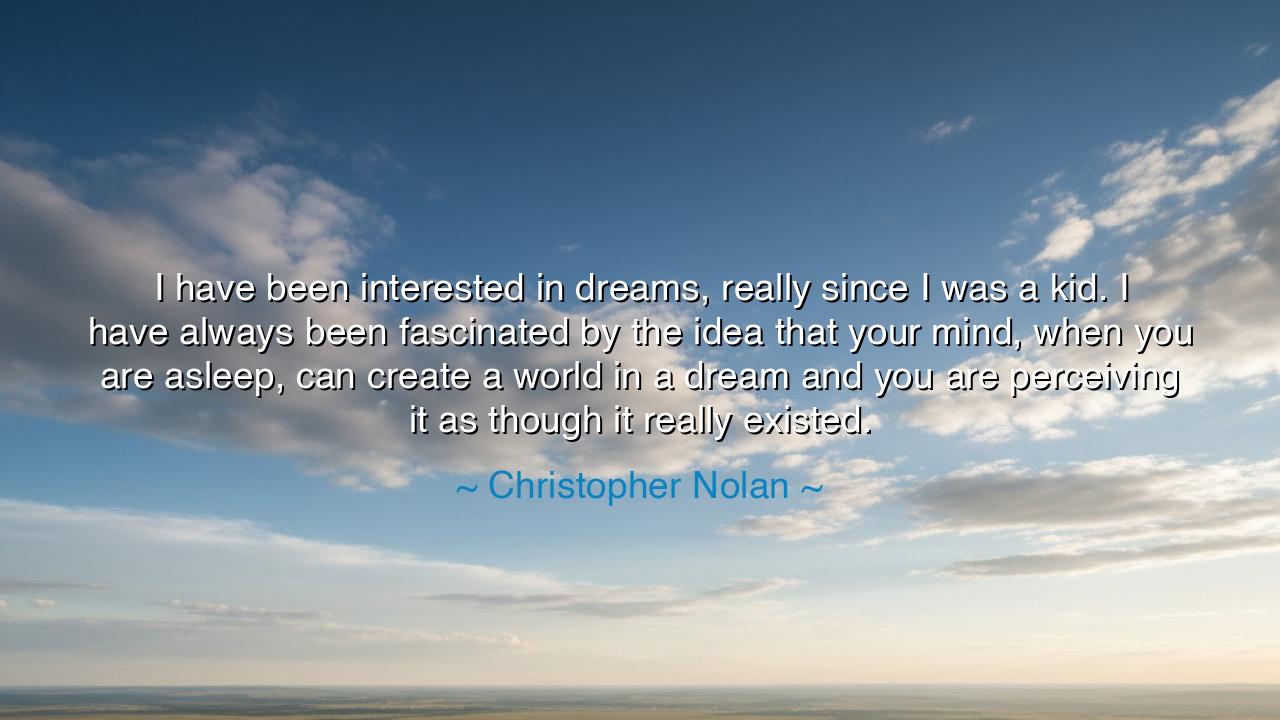
I have been interested in dreams, really since I was a kid. I
I have been interested in dreams, really since I was a kid. I have always been fascinated by the idea that your mind, when you are asleep, can create a world in a dream and you are perceiving it as though it really existed.






When Christopher Nolan, the architect of modern cinematic dreams, said, “I have been interested in dreams, really since I was a kid. I have always been fascinated by the idea that your mind, when you are asleep, can create a world in a dream and you are perceiving it as though it really existed,” he spoke as one who had glimpsed the ancient mystery of the human spirit—the ability to create realities within itself. In his words, there breathes an awe older than time, for long before the screen flickered with illusion, humanity already knew the wonder and terror of dreams. The ancients believed them to be messages from the gods, mirrors of the soul, or doors to other realms. Nolan, with the mind of a philosopher and the imagination of an artist, recognizes in dreams the same creative power that builds civilizations and paints stars in the void.
To dream, whether in sleep or in waking life, is to encounter the boundless power of the mind—a power that does not merely reflect the world but constructs it. In our sleep, the ordinary laws of nature bow before thought; mountains rise at whim, the dead speak, and time itself dissolves. Nolan marvels at this miracle: that the human brain, closed to the world, can open worlds within. And this fascination was not merely poetic—it became the foundation of his art. From his youth, he sensed that the line between reality and imagination is not a wall but a veil, thin and trembling, which both artist and dreamer must pass through. His film Inception would later become a monument to this truth—the dream as creation, the creator as dreamer.
In the ancient world, the Greeks revered Oneiroi, the spirits of dreams who carried messages from the gods to mortals. Philosophers like Plato and Heraclitus pondered whether waking life itself was but a dream of the divine mind. Zhuangzi, the Chinese sage, once dreamed he was a butterfly, and upon waking, wondered if he was a man who had dreamed he was a butterfly, or a butterfly now dreaming he was a man. In all ages, the wise have known what Nolan rediscovered—that reality is not fixed, but fluid, shaped by perception, belief, and imagination. Thus, Nolan stands among them, a modern storyteller of eternal questions: What is real? What is illusion? And who are we, the dreamers of our own existence?
Yet beneath the marvel of his words lies also a warning. The mind, capable of such beauty, is also capable of deception. The same imagination that builds shining worlds can build prisons of fear. Dreams can reveal truth, but they can also entangle us in falsehood. Nolan’s fascination is thus double-edged—wonder at the mind’s infinite creativity, and reverence for its mystery. For he knows that to walk too deeply into one’s dream without awakening is to risk being lost in it. Just as his characters wander the labyrinths of memory and illusion, so too must we learn to discern which of our creations serve life, and which consume it.
The history of art and invention is filled with those who, like Nolan, dreamed worlds that felt real. Consider Leonardo da Vinci, who filled his notebooks with flying machines, cities, and visions centuries ahead of his time. These were not mere sketches—they were the architecture of a dream made tangible. Or think of Mary Shelley, whose nightmare gave birth to Frankenstein, a dream that revealed the terror of unchecked creation. In each, the human mind reached into the realm of the impossible, and from that realm drew forth something eternal. Dreams are the blueprint of progress; every great discovery begins as a vision unseen by others.
And yet, the truest insight of Nolan’s words is not only about cinema, or invention, or art—it is about self-awareness. The mind that dreams is the same mind that questions, that perceives its own perception. When we dream, we are both creator and witness, architect and inhabitant. To realize this is to touch the very essence of consciousness. The dream teaches us that we are not prisoners of the world, but participants in its unfolding. When Nolan speaks of being “fascinated” since childhood, it is because he intuited that every dream reveals a fragment of the divine—the infinite intelligence within the human spirit that mirrors creation itself.
So what is the lesson for us, the listeners of this wisdom? It is this: do not dismiss your dreams, whether they come by night or in the quiet fires of your ambition. Treat them as sacred messages from the deeper mind, guiding you toward who you might yet become. But also remember to awaken—to bring what you dream into the light of action, into the world that others share. Let your imagination be both your sanctuary and your forge. The dream is not an escape from life—it is the seed from which life grows.
In the end, Christopher Nolan’s fascination with dreams is the fascination of every soul that has ever looked within and found a universe. To dream is to remember that we are creators; to awaken is to realize that creation never ceases. Between sleeping and waking, between illusion and truth, lies the human journey—endless, mysterious, divine. And as long as there are those who dream with wonder, the world will never cease to be remade.






AAdministratorAdministrator
Welcome, honored guests. Please leave a comment, we will respond soon